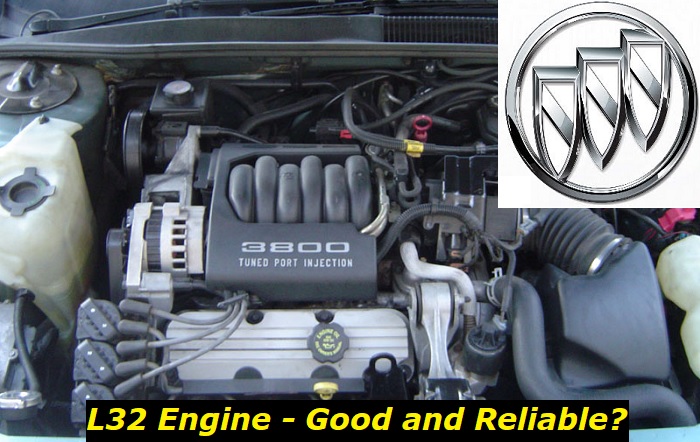The 3800, also known as the Buick V6, is one of the longest-running engine series in the world with its production spanning nearly half a century from 1961 to 2008. It started with the Fireball V6 model and took a bow with the L32 SIII Supercharged model. The engine was considered by Ward's Auto as one of the 10 best engines of the 20th century and one of the 10 Best Engines in the World for three consecutive years from 1995 to 1997.
Being the last of the series, the L32 carried with it the fame of the 3800 and Buick's winning formula in engine development. It exemplified optimal performance, fuel economy, long mileage, and a high level of reliability. The engine had its share of problems along the way, but they were easily eclipsed by its overwhelming praise from owners and automotive experts alike.

Key facts and my opinion about the engine
- Production years: 2003-2007
- Average lifespan of L32: 250,000-300,000 miles
- Fuel supply type: port injection
- Power range: 260 hp
- Fuel efficiency: bad
- Engine block material: cast iron
- Engine reliability score: medium
- The most common problems: coolant leaks, sensors and ignition coils have limited lifespan, minor issues.
L32 Performance
The L32 was a supercharged engine produced between 2004 and 2008 marking the end of the 3800-engine era. The unit carried the key specs of the preceding L26 engine meaning it had a 3.8-liter (3,791 cc) displacement, 1.83-inch intake valves, 1.52-inch exhaust valves, 3.8-inch bore, 3.4-inch stroke, and a compression ratio of 8.5:1.
Fuel delivery is made via a sequential fuel injection system. The engine block and cylinder head all make use of cast iron materials with powder metal connecting rods and a steel camshaft. However, it also introduced several improvements such as the P05 Powertrain Control Module (PCM) with 50 percent more RAM than the P04, electronic throttle control, revised cylinder head design, and Generation V M90 Eaton supercharger.
The L32 engine's Eaton supercharger is a work of engineering excellence. It provides a decent balance of power and efficiency, and is capable of delivering an impressive amount of torque. It's no wonder that this engine is so popular among performance enthusiasts. Translating this statement into numbers, that's a good 260 hp at 5,400 rpm and 280 lb-ft of torque at 3,600 rpm.
The Generation V M90 supercharger is said to be very quiet and efficient. It is reported that the supercharger provides good acceleration and that it can maintain high speeds without any issues. This is all thanks to its improved airflow through the use of larger inlet and outlet ports resulting in a seven percent increase in its volumetric efficiency compared to its predecessor. It has nine percent lower RPM in delivering the same volume of airflow as its previous version and it requires 13 percent less power in spinning the supercharger. The supercharger is also said to be very reliable and has a long lifespan due to its APC Teflon-like coating.
Moreover, the configuration allows up to 18 mpg and 23 mpg fuel economy in city and highway drives, respectively. The numbers may vary depending on certain factors though such as the aerodynamics and weight of the vehicle using it as well as the driving habits of the user.
Overall, the supercharger complemented the L32 in offering an excellent choice for those looking for a high-performance option with matching frugal fuel consumption ratings.
Mileage of the L32 engine
The L32 Series III supercharged engine is one of the most durable engines on the market. It can last for decades and up to 300,000 miles on its clock before requiring an overhaul or replacement.
The numbers are based on claims of owners who were able to stretch its life through regular preventive maintenance and immediately addressing issues that get in the way before they get worse. This is a testament to the quality of engineering and manufacturing that goes into every 3800 engine.
Application of Buick's Legendary L32
The L32 supercharged engine's known application is in the 2004 to 2007 model years of the Pontiac Grand Prix. It is available as an option for the said car. As shown in the earlier sections, the engine is known for its superb power delivery, fuel economy, and durability, which complemented the features of the auto.
The L32 is quite rare nowadays chiefly because it's been more than a decade since Buick stopped its production. Considering its age, most versions of the engine being sold now have been either rebuilt or modified. Because of that, they may no longer come with a warranty. However, you could still probably score a stock version of it somewhere if you're searching for one.
As for the vehicle that used it, the Pontiac Grand Prix is known to be a reliable car, mainly thanks to its engine performance. It's built well and it only had a few major mechanical problems. Even the interior is well-made and comfortable.
This car was a great value for the money with a $22,245 original price tag in its 2007 model. Pontiac really hit a home run with the Grand Prix as it was highly recommended by world-renowned automotive publications like the Kelly Blue Book. It presented itself as a great car for families or anyone who wanted a reliable, affordable sedan during its time.
Reliability: Problems and Common Issues
Amid the critical acclaim for the L32 engine, it carried with it some of the issues that plagued the 3800 range. These include overheating, intermittent power loss, and leaks. This part discusses the common causes of such issues as well as the solutions you can apply if you end up encountering them.
a. Overheating
The following signs indicate that your engine may be overheating:
- Your engine temperature is going off the charts and the warning light is on
- The ride quality of your car feels sluggish
- Steam is coming out of the hood
- You are getting thumping sounds or strange noises from the engine bay
- The air conditioning unit is blowing hot air
There are a few things you can do to diagnose and fix the problem, but before anything else, turn off your engine and let it cool down first. The possible causes of this issue are:
- Low coolant level or inferior coolant quality
- Faulty cooling fans
- Leaks
To fix the problem, we recommend the following:
- Evaluate the coolant level in the radiator. If it's low, add more coolant until it's full. Make sure to use the correct type of coolant for your engine.
- Check the condition of the cooling fans. If they're dirty or damaged, clean or replace them as necessary.
- Monitor the radiator hose for leaks. If you find a leak, replace the hose with a new one.
If these measures don't solve the overheating problem, there's likely a more serious issue with the engine itself that already requires the expertise of a professional mechanic.
b. Intermittent Power Loss
If your L32 Series III engine is losing power intermittently, you may notice one or more of the following symptoms:
- Your auto stalls unexpectedly
- The engine idles roughly
- Your vehicle is struggling to start
- There are engine misfires
There are a few possible causes of intermittent power loss in a Series III engine. These include:
- You have a faulty ignition system
- The spark plugs are either dirty or faulty
- The fuel injector is leaking
- The air filter is either dirty or worn out
If your Series III engine is losing power intermittently, there are a few possible solutions. These include:
- Checking, cleaning, and replacing the spark plugs if needed.
- Checking the ignition system and replacing any damaged parts.
- Replacing the fuel injector if it's worn out.
- Cleaning or replacing the air filter.
Again, it's best to bring your car to a mechanic if the problems persist after applying all these conceivable remedies.
c. Leaks
Leaks in the fuel, oil, or coolant system of the L32 supercharged Series III can manifest through the following symptoms:
- You are experiencing intermittent power losses while driving coupled with hard starts
- There are plenty of droplets of any of the fluids on the ground where your vehicle is parked
- You can sense the pungent smell of fuel near your car's hood
- Sludge can be found in your fuel, oil, or coolant caps and reservoirs
This can be a serious problem, and if not repaired right away, these leaks can lead to engine damage or even failure. The common causes of these are:
- A faulty fuel injector O-ring
- The piston rings are worn
- The seals may be damaged
- The hoses are defective
Here are the solutions you can turn to:
- Replace the fuel injector O-ring.
- Replace the piston rings.
- Change the sealants.
- Change the faulty hoses.
If the issues continue after these solutions, better have your engine inspected and fixed by a qualified mechanic as soon as possible.
What We Think of the L32 Series III Engine
In a nutshell, the L32 Series III engine is certainly one of the best power units ever produced in the past decade because it does a great job of offering outstanding performance, fuel efficiency, mileage, and reliability with only some minor issues to boot. If you happen to own one, better take care of it as this gem is such a very rare specimen nowadays.
About the authors
The CarAraC research team is composed of seasoned auto mechanics and automotive industry professionals, including individuals with advanced degrees and certifications in their field. Our team members boast prestigious credentials, reflecting their extensive knowledge and skills. These qualifications include: IMI: Institute of the Motor Industry, ASE-Certified Master Automobile Technicians; Coventry University, Graduate of MA in Automotive Journalism; Politecnico di Torino, Italy, MS Automotive Engineering; Ss. Cyril and Methodius University in Skopje, Mechanical University in Skopje; TOC Automotive College; DHA Suffa University, Department of Mechanical Engineering






Add comment